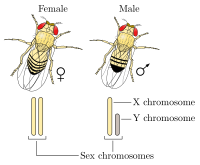Drosophila sex-chromosomes
The XY sex-determination system is found in humans, most other mammals, some insects (Drosophila), some snakes, and some plants (Ginkgo). In this system, the sex of an individual is determined by a pair of sex chromosomes. Females typically have two of the same kind of sex chromosome (XX) and are called the homogametic sex. Males typically have two different kinds of sex chromosomes (XY) and are called the heterogametic sex.
In humans, the presence of the Y chromosome is responsible for
triggering male development; in the absence of the Y chromosome, the
fetus will undergo female development. More specifically, it is the SRY
gene located on the Y chromosome that is of importance to male
differentiation. Variations to the sex gene karyotype could include rare
disorders such as XX males (often due to translocation of the SRY gene to the X chromosome) or XY gonadal dysgenesis in people who are externally female (due to mutations in the SRY gene). In addition, other rare genetic variations such as Turner's (XO) and Klinefelter's (XXY) are seen as well.
The XY system contrasts in several ways with the ZW sex-determination system found in birds, some insects, many reptiles,
and various other animals, in which the heterogametic sex is female. It
had been thought for several decades that, in all snakes, sex was
determined by the ZW system, but there had been observations of
unexpected effects in the genetics of species in the families Boidae and Pythonidae;
for example, parthenogenic reproduction produced only females rather
than males, which is the opposite of what is to be expected in the ZW
system. In the early years of the 21st century such observations
prompted research that demonstrated that all pythons and boas so far
investigated definitely have the XY system of sex determination.
A temperature-dependent sex determination system is found in some reptiles.
Mechanisms
All animals have a set of DNA coding for genes present on chromosomes. In humans, most mammals, and some other species, two of the chromosomes, called the X chromosome and Y chromosome, code for sex. In these species, one or more genes are present on their Y chromosome that determine maleness. In this process, an X chromosome and a Y chromosome
act to determine the sex of offspring, often due to genes located on
the Y chromosome that code for maleness. Offspring have two sex
chromosomes: an offspring with two X chromosomes will develop female
characteristics, and an offspring with an X and a Y chromosome will
develop male characteristics.
Humans
Human male XY chromosomes after G-banding
In humans, half of spermatozoons carry X chromosome and the other half Y chromosome. A single gene (SRY)
present on the Y chromosome acts as a signal to set the developmental
pathway towards maleness. Presence of this gene starts off the process
of virilization. This and other factors result in the sex differences in humans. The cells in females, with two X chromosomes, undergo X-inactivation, in which one of the two X chromosomes is inactivated. The inactivated X chromosome remains within a cell as a Barr body.
Humans, as well as some other organisms, can have a rare
chromosomal arrangement that is contrary to their phenotypic sex; for
example, XX males or XY gonadal dysgenesis (see androgen insensitivity syndrome). Additionally, an abnormal number of sex chromosomes (aneuploidy) may be present, such as Turner's syndrome, in which a single X chromosome is present, and Klinefelter's syndrome, in which two X chromosomes and a Y chromosome are present, XYY syndrome and XXYY syndrome. Other less common chromosomal arrangements include: triple X syndrome, 48, XXXX, and 49, XXXXX.
Other animals
In
most mammals, sex is determined by presence of the Y chromosome.
"Female" is the default sex, due to the absence of the Y chromosome. In the 1930s, Alfred Jost determined that the presence of testosterone was required for Wolffian duct development in the male rabbit.
SRY is a sex-determining gene on the Y chromosome in the therians (placental mammals and marsupials). Non-human mammals use several genes on the Y chromosome. Not all male-specific genes are located on the Y chromosome. Platypus, a monotreme, use five pairs of different XY chromosomes with six groups of male-linked genes, AMH being the master switch. Other species (including most Drosophila
species) use the presence of two X chromosomes to determine femaleness:
one X chromosome gives putative maleness, but the presence of Y
chromosome genes is required for normal male development.
Other systems
Birds and many insects have a similar system of sex determination (ZW sex-determination system), in which it is the females that are heterogametic (ZW), while males are homogametic (ZZ).
Many insects of the order Hymenoptera instead have a system (the haplo-diploid sex-determination system), where the males are haploid individuals (which have just one chromosome of each type), while the females are diploid (with chromosomes appearing in pairs). Some other insects have the X0 sex-determination system,
where just one chromosome type appears in pairs for the female but
alone in the males, while all other chromosomes appear in pairs in both
sexes.
Influences
Genetic
PBB Protein SRY image
It has long been believed that the female form was the default
template for the mammalian fetuses of both sexes. After the discovery of
the testis-determining gene SRY,
many scientists shifted to the theory that the genetic mechanism that
causes a fetus to develop into a male form was initiated by the SRY
gene, which was thought to be responsible for the production of testosterone
and its overall effects on body and brain development. This perspective
still shares the classical way of thinking; that in order to produce
two sexes, nature has developed a default female pathway and an active
pathway by which male genes would initiate the process of determining a
male sex, as something that is developed in addition to and based on the
default female form. However, In an interview for the Rediscovering Biology website, researcher Eric Vilain described how the paradigm changed since the discovery of the SRY gene:
For a long time we thought that SRY would activate a cascade of male genes. It turns out that the sex determination pathway is probably more complicated and SRY may in fact inhibit some anti-male genes.
The idea is instead of having a simplistic mechanism by which you have pro-male genes going all the way to make a male, in fact there is a solid balance between pro-male genes and anti-male genes and if there is a little too much of anti-male genes, there may be a female born and if there is a little too much of pro-male genes then there will be a male born.
We [are] entering this new era in molecular biology of sex determination where it's a more subtle dosage of genes, some pro-males, some pro-females, some anti-males, some anti-females that all interplay with each other rather than a simple linear pathway of genes going one after the other, which makes it very fascinating but very complicated to study.
In mammals, including humans, the SRY gene is responsible with triggering the development of non-differentiated gonads into testes, rather than ovaries. However, there are cases in which testes can develop in the absence of an SRY gene. In these cases, the SOX9
gene, involved in the development of testes, can induce their
development without the aid of SRY. In the absence of SRY and SOX9, no
testes can develop and the path is clear for the development of ovaries.
Even so, the absence of the SRY gene or the silencing of the SOX9 gene
are not enough to trigger sexual differentiation of a fetus in the
female direction. A recent finding suggests that ovary development and
maintenance is an active process, regulated by the expression of a "pro-female" gene, FOXL2. In an interview for the TimesOnline edition, study co-author Robin Lovell-Badge explained the significance of the discovery:
We take it for granted that we maintain the sex we are born with, including whether we have testes or ovaries. But this work shows that the activity of a single gene, FOXL2, is all that prevents adult ovary cells turning into cells found in testes.
Implications
Looking
into the genetic determinants of human sex can have wide-ranging
consequences. Scientists have been studying different sex determination
systems in fruit flies
and animal models to attempt an understanding of how the genetics of
sexual differentiation can influence biological processes like
reproduction, ageing and disease.
Maternal
In humans and many other species of animals, the father determines the sex of the child. In the XY sex-determination system, the female-provided ovum contributes an X chromosome and the male-provided sperm contributes either an X chromosome or a Y chromosome, resulting in female (XX) or male (XY) offspring, respectively.
Hormone levels in the male parent affect the sex ratio of sperm in humans. Maternal influences also impact which sperm are more likely to achieve conception.
Human ova, like those of other mammals, are covered with a thick translucent layer called the zona pellucida, which the sperm must penetrate to fertilize the egg. Once viewed simply as an impediment to fertilization,
recent research indicates the zona pellucida may instead function as a
sophisticated biological security system that chemically controls the
entry of the sperm into the egg and protects the fertilized egg from
additional sperm.
Recent research indicates that human ova may produce a chemical
which appears to attract sperm and influence their swimming motion.
However, not all sperm are positively impacted; some appear to remain
uninfluenced and some actually move away from the egg.
Maternal influences may also be possible that affect sex determination in such a way as to produce fraternal twins equally weighted between one male and one female.
The time at which insemination occurs during the estrus cycle has been found to affect the sex ratio of the offspring of humans, cattle, hamsters, and other mammals.
Hormonal and pH conditions within the female reproductive tract vary
with time, and this affects the sex ratio of the sperm that reach the
egg.
Sex-specific mortality of embryos also occurs.
History
Ancient ideas on sex determination
Aristotle believed that the sex of an infant is determined by how much heat a man's sperm had during insemination. He wrote:
...the semen of the male differs from the corresponding secretion of the female in that it contains a principle within itself of such a kind as to set up movements also in the embryo and to concoct thoroughly the ultimate nourishment, whereas the secretion of the female contains material alone. If, then, the male element prevails it draws the female element into itself, but if it is prevailed over it changes into the opposite or is destroyed.
Aristotle claimed that the male principle was the driver behind sex determination, such that if the male principle was insufficiently expressed during reproduction, the fetus would develop as a female.
20th century genetics
Nettie Stevens and Edmund Beecher Wilson
are credited with independently discovering, in 1905, the chromosomal
XY sex-determination system, i.e. the fact that males have XY sex chromosomes and females have XX sex chromosomes.
The first clues to the existence of a factor that determines the
development of testis in mammals came from experiments carried out by Alfred Jost, who castrated embryonic rabbits in utero and noticed that they all developed as female.
In 1959, C. E. Ford and his team, in the wake of Jost's experiments, discovered that the Y chromosome was needed for a fetus to develop as male when they examined patients with Turner's syndrome, who grew up as phenotypic females, and found them to be X0 (hemizygous for X and no Y). At the same time, Jacob & Strong described a case of a patient with Klinefelter syndrome (XXY), which implicated the presence of a Y chromosome in development of maleness.
All these observations lead to a consensus that a dominant gene that determines testis development (TDF) must exist on the human Y chromosome. The search for this testis-determining factor (TDF) led a team of scientists in 1990 to discover a region of the Y chromosome that is necessary for the male sex determination, which was named SRY (sex-determining region of the Y chromosome).




